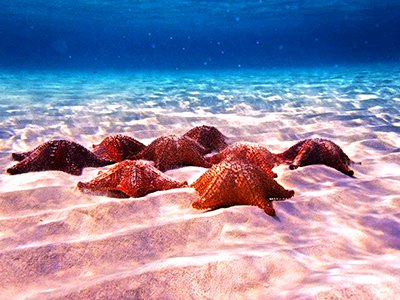It is important not to buy dry starfish or handicrafts made from them. It is best to enjoy them in their natural environment….
QUINTANA ROO — Undoubtedly one of the strangest animals in both its behavior and physiology is the starfish. There are just over 1900 species of this animal that are distributed around the world. They can live from the intertidal zone to 6,000 meters deep exclusively in marine waters. Each one has characteristics totally different from each other.
The most common species in Quintana Roo, the star cushion (Oreaster reticulatus), measures from 30cm up to 50cm from tip to tip, It is considered an adult star from the maximum radius of 12 cm, and its coloration at this age is red, pink or orange, whereas the young ones have greenish colors and with spots that help to camouflage themselves. Most stars are made up of a central part surrounded by 5 arms that have the facility to regenerate if they are injured.
Its hard structure is formed of calcareous plaques, a kind of calcium, which has holes through which leaks the gills, which extract oxygen from the water, allowing breathing. These types of stars can’t breathe out of the water.
They are found mainly on sandy, muddy surfaces, in marine grasslands or near mangroves, the latter shelter commonly used in young stars.
Its displacement is totally out of this world, because inside its hard structure, it keeps a vascular system that is under pressure, and has hundreds of small feet full of water that allows movement. In the cushion star, it is a slow and exclusively underwater movement.
They eat small invertebrates, crustaceans, mollusk and they even eat other starfish. To do this, they remove their stomach as it has surmounted their prey, releasing their gastric juices to be able to digest the soft tissues. On the other hand, the main predator in adulthood is people, and in some areas Triton snails. However, in the young age, they have many more predators, for example, seagulls.
And finally their reproduction also depends totally on the species, there are some that are hermaphrodite, others that change sex with age and in the case of the cushion star, there are male individuals and female individuals. However, Biol. Vanessa Francisco, Field Officer of the National Park of the Arrecife National Park of Puerto Morelos, tells us that it is impossible to know their sex by observing them, the only way is to witness the moment in which each one expels the sperm and the eggs respectively.
This fertilization occurs entirely in water, unlike other species, independently releasing the gametes. When the egg is fertilized a larva is formed that has mobility and tends to be fixed near the adults of the same species, finally to undergo a process of metamorphosis that turns it into a starfish.
Source: laverdadnoticias.com





